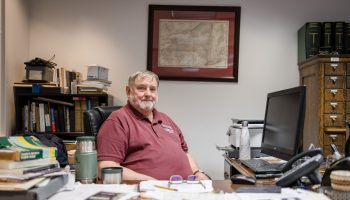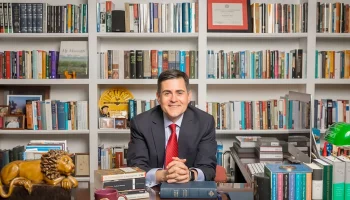
Liz DeLillo
Staff writer
Economist Nomi Prins’ advice? Think real, think big and think bold.
Prins spoke at 10:45 a.m. Thursday in the Amphitheater as part of the Chautauqua Lecture Series Week Five theme, “Innovation in Capitalism: How to Meet 21st-Century Challenges?” In her lecture, Prims focused on the concept she’s dubbed “permanent distortion.”
“The point of permanent distortion is that it is permanent — and there are reasons for it — but we are also in a shift right now where the true innovation in capitalism is to use what is real, to build what lasts,” she said.
Prins is an economist, author, financial historian and geopolitical financial expert, and received her Doctor of Philosophy in international strategic studies with a specialization in international political economy. A Wall Street insider, she held positions at Lehman Brothers and Chase Manhattan Bank as well as senior roles at Goldman Sachs and Bear Stearns in London. Prins left Wall Street to draw attention to the manipulation of financial systems and coined the concept “permanent distortion” to educate people on the gap between financial markets and the real economy.
“The transparency of what happens to numbers as they get manifested in financial engineering was something I was basically informed of by doing when I first started,” Prins said. “… But I also threw out that entire arc. I always felt there was this disconnect that existed between the numbers, between the deals and between the real world.”
At Goldman Sachs, she managed groups that partook in this kind of financial engineering.
“It was something that always dug at me from when I was in Wall Street,” Prins said. “Years later, I gave this name to it, ‘permanent distortion,’ which is that disconnect, that gap, between what happens in the financial system, what happens in the markets and what is felt and occurs in the real economy that we are in every single day.”
She discussed the S&P 500, highlighting the differences between the stock market and the economy.
“Yesterday, the S&P 500 hit another record high. This is very good for anybody invested in the stock market, … but the reality is, if we look at the economy underlying the stock market, GDP in the first quarter was down by half a percent,” Prins said. “Adjusted for inflation, which is at 2.7%, it was down by closer to 3%.”
Beyond the numbers, this disconnect between the market and economy is evident in consumer behavior, too.
“Consumer spending is down. Savings is down. Disposable income is down. So, the way in which the average American in the actual economy exists has not kept up with those historical highs we keep on seeing in the S&P 500 and other areas of the markets,” Prins said. “… My perspective is there is leverage in the market that allows for speculation and creative investment that does not care about what is happening in the real economy.”
One of the major problems households face now is debt. A recent study by the Federal Reserve Bank of New York identified the debt for average households totals to $18.2 trillion, Prins said. The country is facing $37 trillion of debt nationally.
“No one likes debt — that’s why there are so many intense conversations that happen in Congress when it comes time to talk about budgets and bills,” Prins said. “No one in a household likes debt, but it is a necessity. For example, rents are 40% of the average American’s take home (pay), and they are higher in some cities than others.”
The “big numbers” say that grocery costs are up by 6%, and wages have gone up only 1.7%.
“Because we are all servicing our debt, it is harder and harder to think about the future,” Prins said. “… What that does, as necessary as it might be on a temporary-moment basis, is it takes you away from being able to think big, bold — to think New Deal, to think Hoover Dam — because servicing of the debt comes first.”
The mindset cultivated through perpetually managing debt is not the only problem this debt produces.
“Now, there is a situation where the monetary policy is baked into the S&P 500 being at historic highs because the Fed is sitting on a book of assets of $6.8 trillion,” Prins said. “… It is a big number, but what it actually symbolizes for Wall Street (is that) there is this cushion of debt, and the Fed is the largest buyer of U.S. Treasury debt. It helps the debt in that respect, but it also provides liquidity or subsidies to Wall Street years after the crisis and also years after COVID.”
However, Wall Street has also taken a new approach with their investing.
“Wall Street is on to something new, and this is why this moment is so important in terms of true innovations and capitalism — using what is real to build what lasts,” Prins said. “… What they (Wall Street) are pivoting to — and this is important for us to consider in your investments and in this moment and thinking big about our economic futures in development — is that it is shifting towards real assets.”
This past year, Prins said, exchange-traded funds moved $330 billion of investments out of bonds and debt and put $220 billion into commodities like gold, silver, copper and uranium.
“We have a different situation today with Wall Street moving into real assets because institutional clients are saying, … ‘We don’t really want to get involved in deals that are merely backed by leveraged debt. … More than that, we want to know where those assets are coming from. We want to make sure that the custody is secure,’ ” Prins said.
Prins qualified Wall Street’s investments into infrastructure, however.
“It is not necessarily good to have all of our infrastructure be financed and controlled by the banking system. Because here is a secret: They don’t really care about the public good. They care about quarterly profits and annual bonuses. I was there — I know,” she said.
The many deals in energy and commodity companies this year is part of this movement to invest in what is real. This year, Wall Street invested $1.5 trillion into infrastructure. While Wall Street clients’ investment preferences are a factor in this shift, it is not the only driving force.
“The American Society of Civil Engineers launched a report, as they do every four years, where they graded the quality of American infrastructure across 18 different segments — ports, water, waste, bridges, roads, hospitals, 18 different areas — and they said, ‘OK, you guys got a C.’ Our country gets a C in infrastructure,” she said.
Infrastructural shortcomings regarding the energy grid were grimmer.
“Energy gets a D-plus — that’s not where we want to be,” Prins said. “… They calculated that there is a short fall of $3.7 trillion that is needed to just get our infrastructure up to base. Not to go forward, not to have better grids, not to have high speed (but) literally to be repaired is $3.7 trillion across the country.”
She discussed a study from the Department of Energy, which found that the country may have 100 times the current number of blackouts by 2030 if the energy grid is not repaired.
“This is where the crisis comes in. This is an economic crisis. If you don’t have power, you cannot do things,” Prins said. “… There are so many things we need electric TEUs for in our grids. 70% of them are over 25 years old, and they were built for an era where none of this stuff existed. This is an example where Wall Street is coming in strong, but we can learn from that.”
The trend of investing in real, physical goods is not limited to Wall Street but is a global phenomenon.
“We are deficient in trying to figure out long-term funding from the redeployment of debt into long-term economic growth. That is something that must change. That is something where we need to really go bold,” Prins said. “That is the anchor that is going to take us forward from this really important moment going forward, and it is a shift that is not just happening in Wall Street, it is happening throughout the world with respect to real assets and commodities.”
For example, investments in gold, silver and copper are rising, with gold outperforming the S&P.
“Other central banks around the world are increasing their stockpile of real assets because it is something called a tier one asset. It means it can be used for liquidity purposes instead of debt for that country’s own financial system,” she said. “Instead of borrowing and then placing their debt with their central banks, gold starts to take a bit of that space.”
Using the People’s Bank of China as an example, Prins explained how China decreased the amount of U.S. debt it holds from $1.4 trillion to $750 billion since the 2008 financial crisis.
“There are political reasons for that. There are geopolitical reasons for that, but the major reason for that is to have something that anchors the liquidity of their system and something that can be used on the trading table as real collateral,” Prins said. “… This kind of shift is not going away. Silver is at 13-year highs, and silver has other uses. It has industrial use values.”
Silver is used in solar panels and plants. On the other hand, copper is essential for electrical wiring and is stockpiled in reserves across the world.
“What it means is, if we actually have a growth policy to use those assets, then they don’t simply make prices go up in the supply chain. They can actually be deployed into real growth and real strategy,” Prins said. “… (If we) have a growth strategy for those assets again, using real assets to build lasting things, then we have something.”
Prins is on the advisory board of the National Infrastructure Bank and elaborated on its approach with this kind of strategy.
“It is an initiative to create a different way of using capital. It is to take a page out of Wall Street’s book, which is to repurpose debt — not leverage, just repurpose,” Prins said. “… The idea would be we would be able to finance our future in a way where the money is actually lasting and revolving and actually uses the debt in order to repurpose our economic development.”
In addition to contemporary inspiration, she looked to American history.
“We need an FDR-style, Eisenhower-style innovation in capitalism that allows the deployment of debt to long-term economic investment to help all of our economic sectors grow,” she said.
Prins spent time perusing the archives of the FDR library when she wrote Other People’s Money: The Corporate Mugging of America. She discussed a speech FDR gave in 1936 and how it helped her think about her Chautauqua lecture — his “I Hate War” speech, given on the Amp stage.
“I read that speech many times before coming here, and it was definitely a warning about not getting into war,” she said. “I think digging into it even more with the lens of where we are at now, versus that history that was unfolding at the time, it was about being prepared for the future. It was about being prepared for crises that were evolving that could come.”
Prins returned to FDR’s speech again near the end of her lecture, reinterpreting it in light of our current economic situation.
“He said peace, like charity, begins at home. Now again, this was pre-wartime. It was postdepression (and) post-New Deal. It was around the TVA time — a lot of moving parts,” Prins said. “But when I’m looking back, in this lens of today, at that history, the way I look at peace — aside from the obvious, related to not-war — is economic peace. Economic peace is built on economic security.”
Elaborating her point on economic peace, Prins explained how that might be achieved.
“We can have a sustained economic peace that is attached to this entire historical arc, and even weather this arc, when real assets were used to build the country. They should be used in a way that involves all of us, so they can be deployed for the public good and not just the private profit of Wall Street or Blackstone or BlackRock,” Prins said. “… We have to go big; we have to go bold. We have done this before in the country. We are just arguing with ourselves — and by ourselves, I mean in Congress.”
Prins closed with a suggestion to Chautauquans.
“Think about how we can keep going big, how we can harness real assets to build real things and what our parts in all of that can be, because we can choose to perpetuate financial illusion,” Prins said. “We can look at our 401K reports and see the market is going up, or we can move past financial illusion and structured deal and leveraged debt into what is real — into actually allowing the economy to be what drives the numbers and not financial engineering.”




